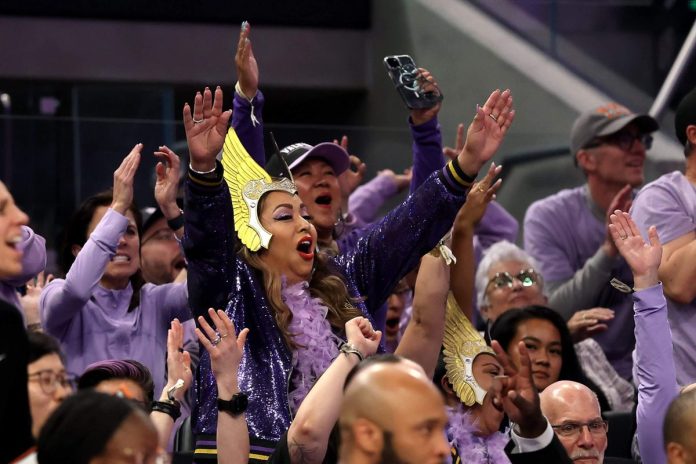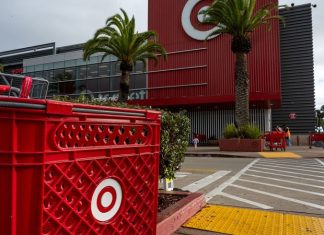A timeout during a Golden State Valkyries game against visiting Indiana turned down the volume inside Chase Center. It was chance for the raucous fans to breathe and recharge.
Then Angela Davis was introduced.
Instantly, the volume returned, as if an invisible knob was suddenly pushed to its max. Davis, at 81 years young, her once-robust dark afro now a silver shoulder-length bob, waved to a crowd of 18,000 fans getting to their feet, serenading a worthy icon. A revolutionary. A feminist. One of Time Magazine’s 100 most influential people in the world.
She beat the GSV drum, and the crowd continued its roar. Such moments tend to produce an obligatory applause, a placating gesture of respect. But these Valkyries fans understood whose presence they shared. They knew Davis. Their appreciation and awareness explain why they routinely converge on San Francisco to pack an NBA arena. Then, when a scheduling conflict moved the Valkyries’ home playoff game to San Jose, they packed an NHL arena — filled it with a fervor familiar in these parts.
This is why the Bay Area is a mecca for women’s sports. Because this spirit lives here.
This place takes pride in its affinity for women. It’s in the political DNA, the artistic heartbeat, the social aesthetic. America still struggles with the equality and inherent regard women deserve, and the Bay Area loves little more than being a beacon for such ambitions and executions. In these parts, women fight. With intellect. For power. In defiance. And women who fight, who rebuke ceilings and dare to achieve greatness, will never be alone here.
So of course women’s sports thrive here.
Of course the Bay turned Stanford’s campus into a cathedral for women’s hoops, and treated Tara VanDerveer with reverence. Even with the San Francisco 49ers and Oakland A’s winning, the Bay still made room to soak in the 1990 championship run with Jennifer Azzi and Katy Steding, and then in 1992 with Val Whiting. We knew Jamila Wideman, Kate Starbird, Candice Wiggins, Nicole Powell, Jayne Appel and the Ogwumike sisters. They were stars here.
Of course everybody here understood the symbolism, the rebellion and agency illustrated in Brandi Chastain’s historic celebration. When she clinched the 1999 World Cup with a penalty kick and ripped off her jersey, Chastain was a Bay Area woman on Bay Area turf flexing Bay Area moxie. The world went crazy. The Bay turned up.
Because here, sports and politics are like a good mixed drink. No stick to sports here. Women athletes and their games are metaphors for the perennial struggle. If not blatantly, inspirationally. The politics create the culture that tells Walnut Creek’s Sabrina Ionescu that she absolutely could idolize Steph Curry as a teen and become a superstar like him. So Bay Area fans felt the chills when she won Game 3 of the 2024 NBA Finals with a buzzer-beating 3. Ionescu made good on the permission she received to be great.
The same liberation-minded spirit forged Naomi Girma. Her family blossomed in an Ethiopian community in San Jose, where her immigrant parents met and raised their soccer prodigy. She honed her craft at grassroots clubs that treated girls’ soccer with the seriousness of civic duty. The Bay Area fertilized her brilliance — from the Central Valley Crossfire to Pioneer High to Stanford. Earlier, she sparked a wave of expensive transfers when Chelsea paid $1.1 million for her services from the San Diego Wave.
People here screamed louder for Natalie Coughlin, the Vallejo girl who was a superstar at Carondelet High School in Concord before becoming a household name at Cal on her way to three Olympic golds in the backstroke. People here understood the moment when Hayward-native Kristi Yamaguchi, fresh off gold in the 1992 Winter Olympics, took gold in the World Championships at the Oakland Coliseum a month later. A third-generation Japanese-American, whose mother was born in an internment camp, proved she was the best in the world. At home.
Peruse the decades of Bay Area sports and you’ll witness the same thing over and over: women. On the front lines of protests. In the lecture halls, reshaping discourse. Women on corporate boards steering futures. Women in the streets demanding justice. Women in sports delivering moments that reverberate far past shorelines, with women in the crowds putting a battery in their backs.
The Bay doesn’t just support women’s sports, it centers them. It elevates them. It multiplies them. It invests in them by buying tickets and merch. Tens of thousands of people will drop everything to watch women hoop, swim, skate, run, pass, score. Shine.
So of course when the Bay FC plays a game at the home of the San Francisco Giants, the Bay Area makes history. The largest crowd in American history for a U.S. professional sport: 40,091. They turned an NWSL regular-season match into a landmark event. A statement of Bay Area loyalty and consciousness.
The Bay Area has been loving on women athletes — their talent, their brilliance, their drive — for as long as anyone can remember. Locals and imports. Nationals and internationals.
It’s where local high schools, colleges and club teams produce Olympic legends and groundbreaking champions. It’s how an expansion WNBA team can lead the league in attendance and flood the streets with its colors.
It’s why when Angela Davis pulls up, everyone understands the assignment.




![Google TV gets a new indoor solar remote design [Gallery]](https://poxte.com/wp-content/uploads/2025/11/google-tv-solar-remote-design-3-324x235.jpg)


